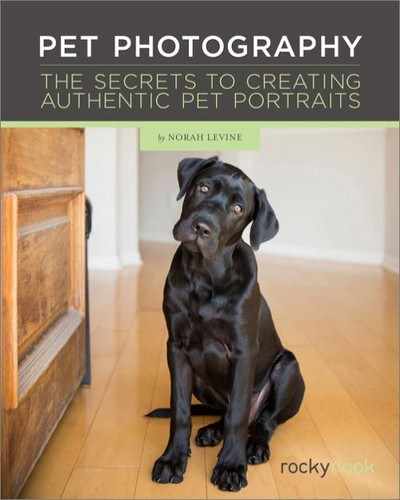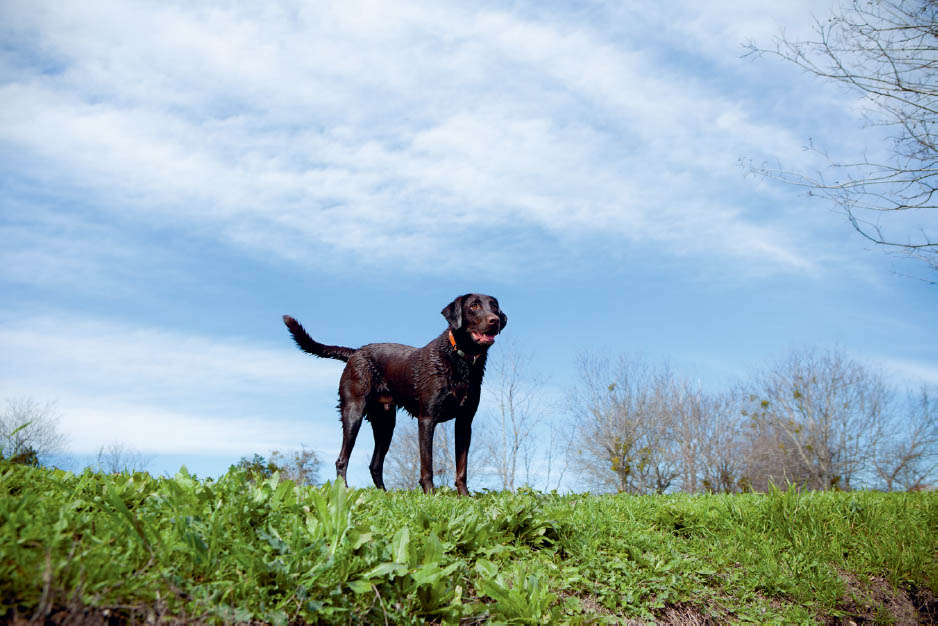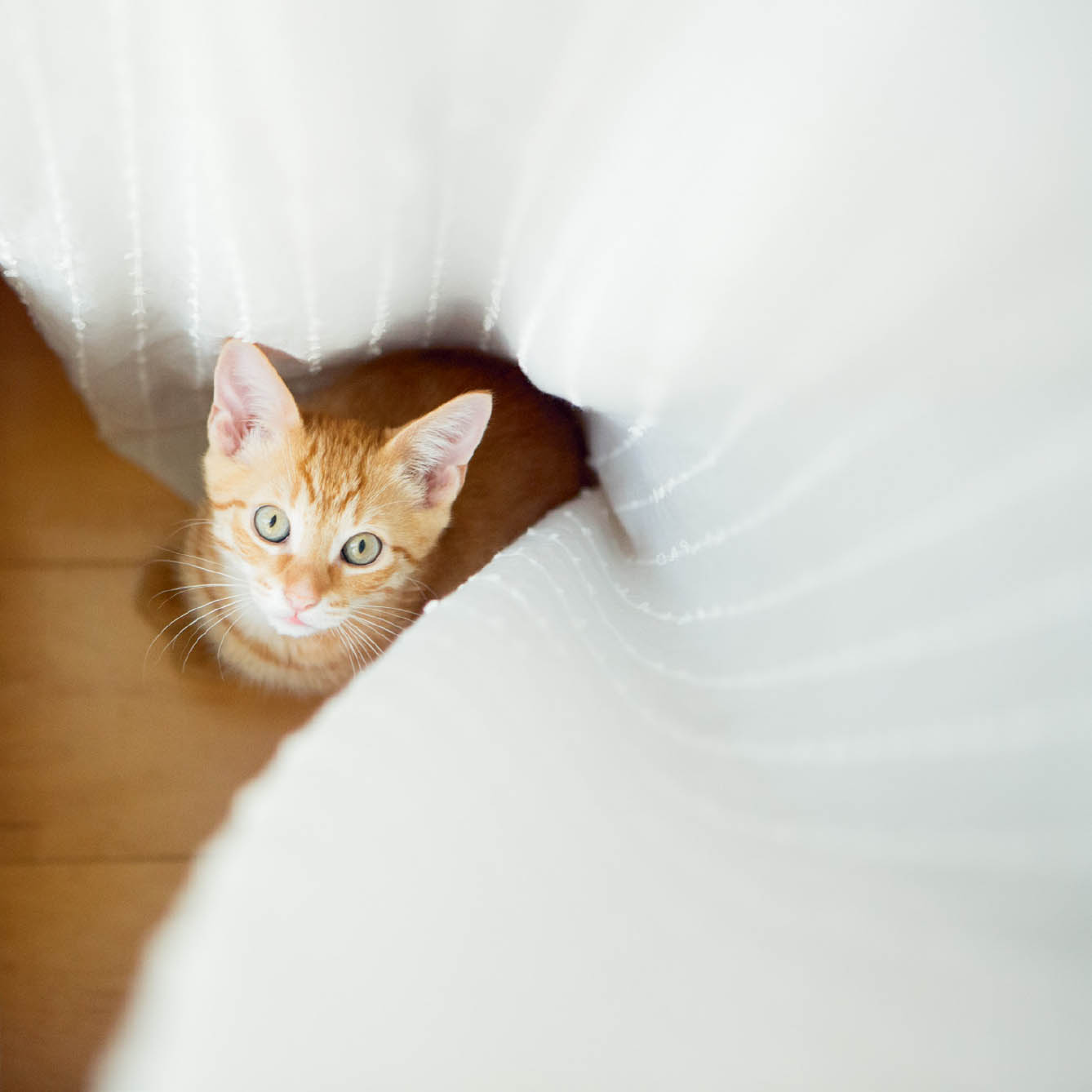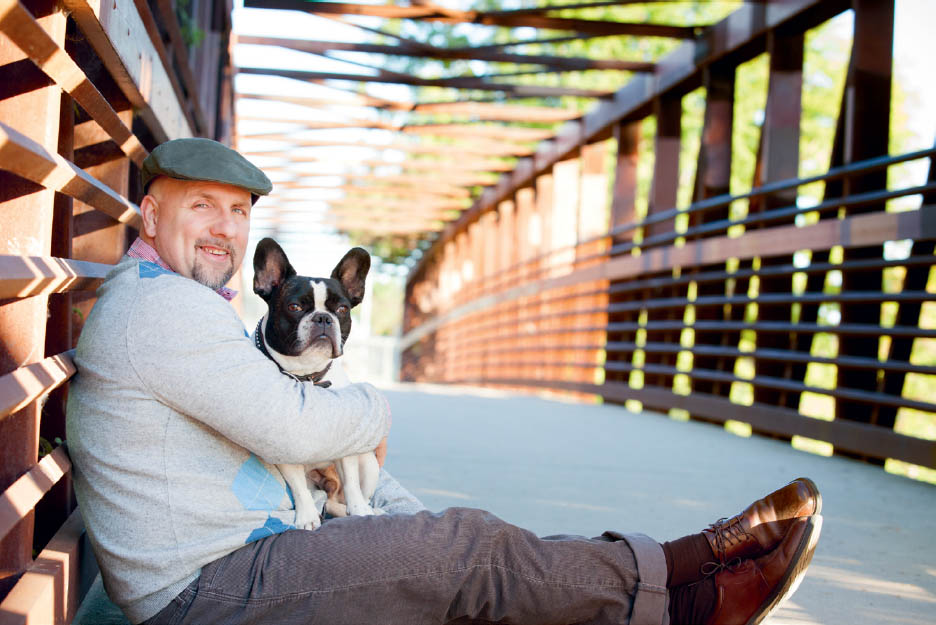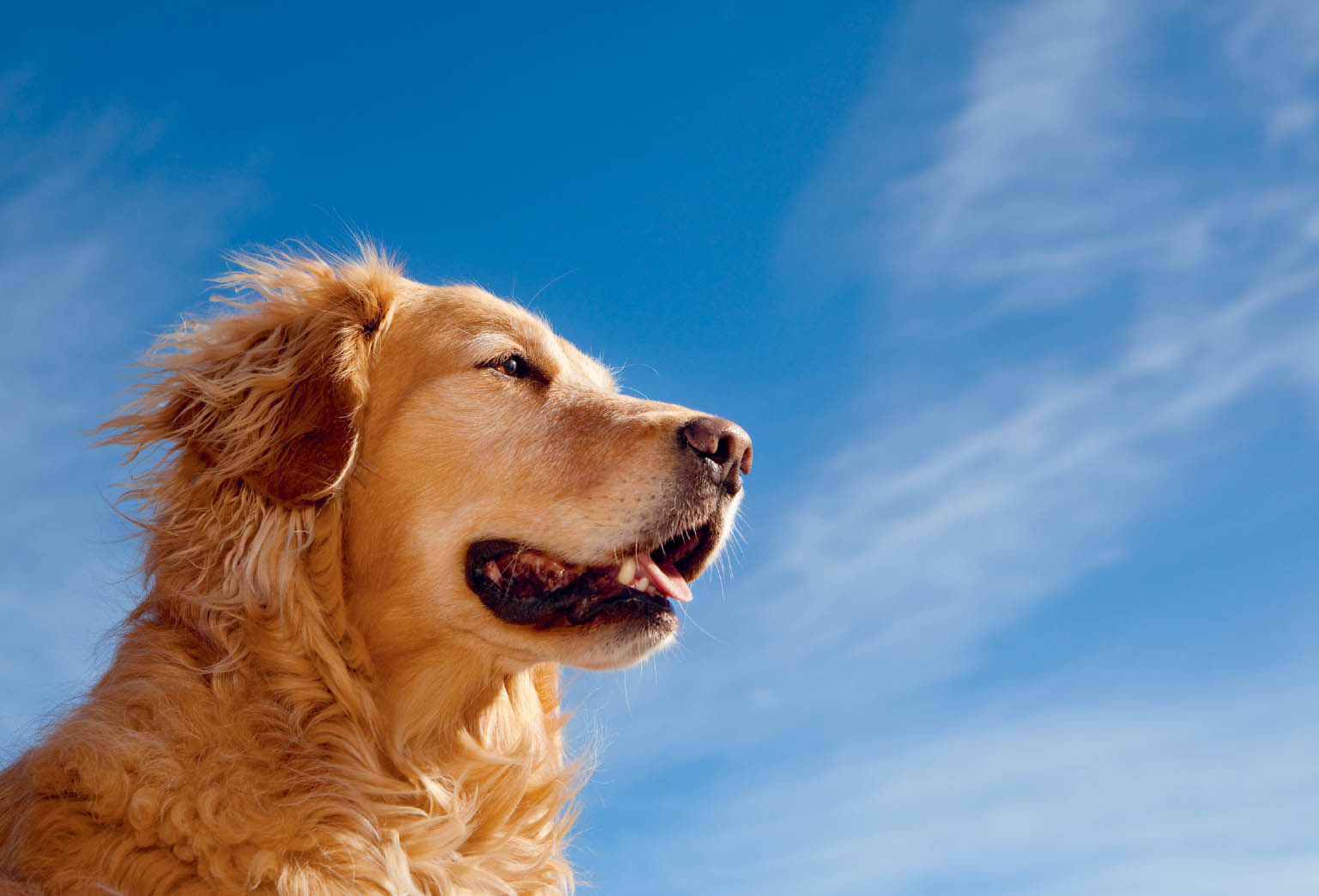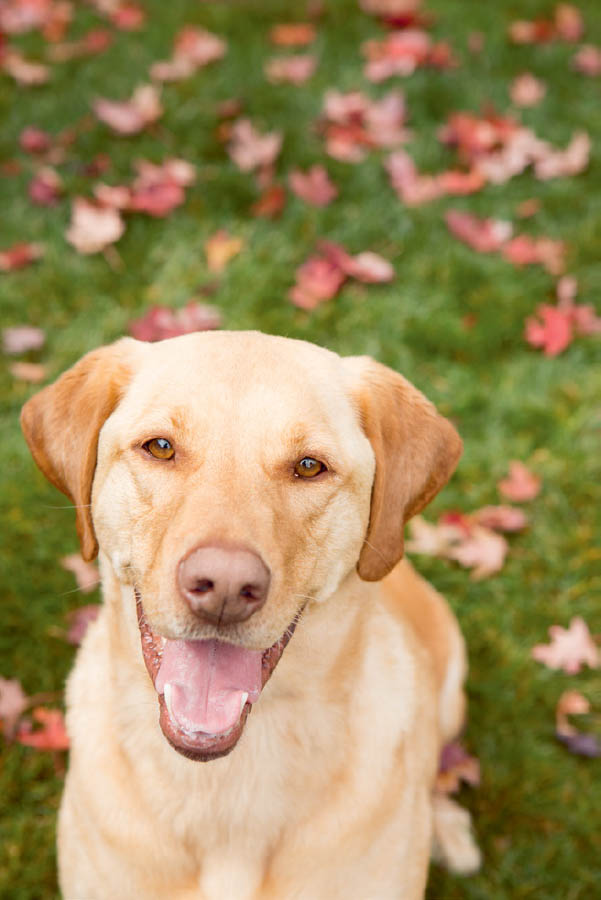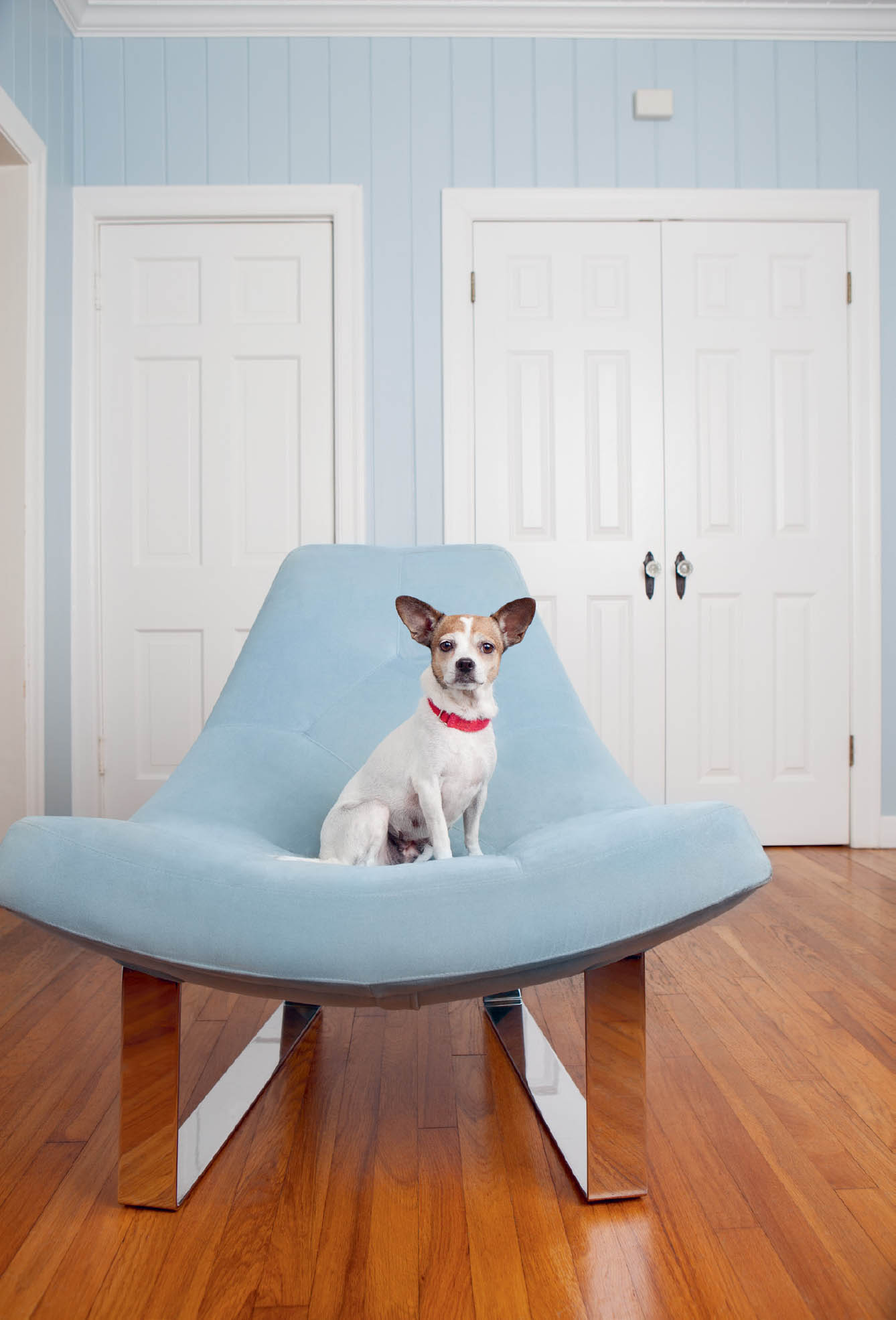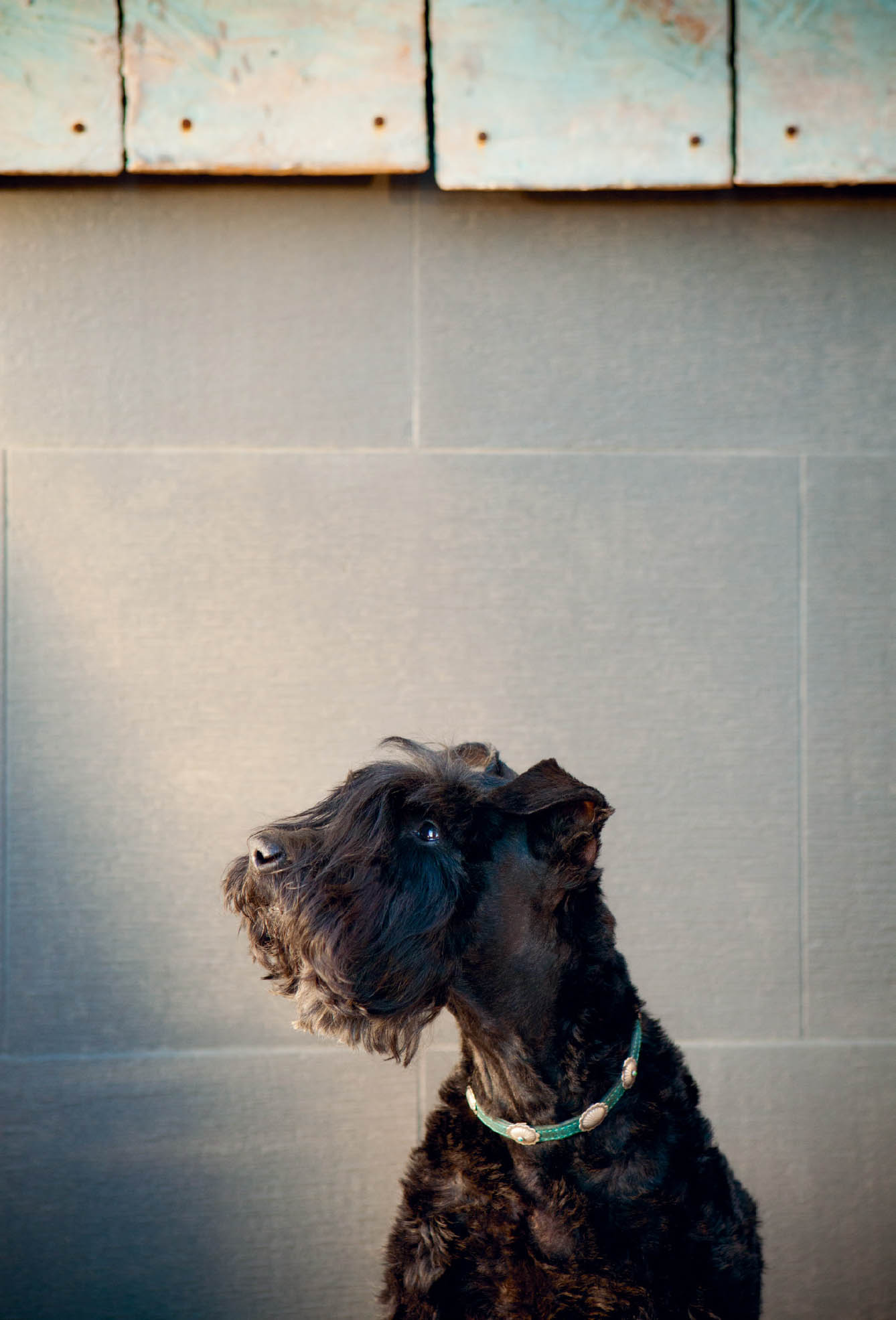CHAPTER 4: COMPOSITION, COLOR, AND CREATIVITY
In this chapter, I’ll be diving into a discussion of composition, color, and creativity in pet portraits. Each of these topics plays a supportive role to the others, and while they all apply to other genres of photography, specific considerations with regard to pet photography are well worth exploring.
Composition
Whether you’re creating a photograph, constructing a painting, designing a building, or even decorating a room, composition plays an integral role to the overall aesthetic of the final product. Composition should play a role in your image and your goals for that image, no matter what kind of photograph you’re creating. Pet photography may seem “cutesy” to some, but I assure you that successful images require the same considerations of composition as any other form of art—with animals added to the mix.
Paying attention to composition and making intentional choices about what to include (or not include) in your pet photography will help make you a stronger, more successful photographer. Learning the rules of composition is a really helpful way to train your eye so that when you create a successful image, you know what contributed to its success and you can create more. Later, you can decide to break the rules as much as you want, but do so with intention and understanding of why you’re making those choices.
RULE OF THIRDS
One of the compositional challenges I notice in pet photography is the “headshot” look. This completely symmetrical, centered closeup image of a dog, cat, or horse gets the job done in terms of recording a particular animal, but it does very little, aesthetically, for the viewer of the photograph. Headshot images of pets can also be creatively limiting for the photographer. Keeping the rule of thirds in mind can help solve this problem.
You may remember that the rule of thirds is the concept of imagining a grid that divides the frame into thirds both horizontally and vertically, leaving four cross-section points. By placing a point or points of interest in one of the cross sections, you are already adding dimension to the image.
Placing an animal’s face or body a little off-center gives the viewer’s eye more breathing room in the other parts of the photograph. It can also be more interesting than a straightforward, symmetrical image that looks like a headshot. This isn’t to say that all images need to be off-centered and that no symmetrical images with a pet’s face or body centered are beautiful or impactful.
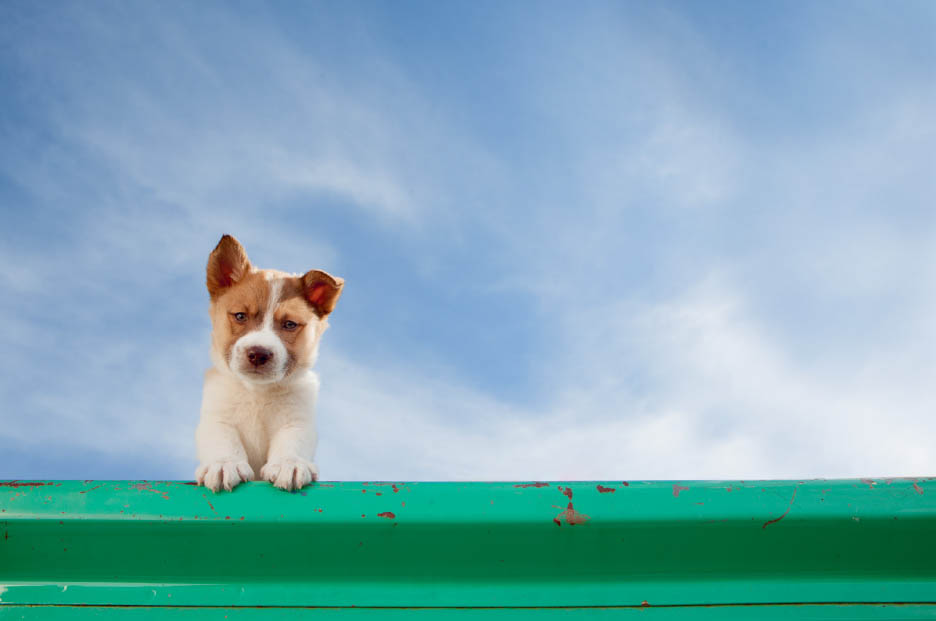
I framed the puppy by implementing the rule of thirds with both the position of the pup and the horizontal section of the truck.
Because the rule of thirds divides the frame into thirds both horizontally and vertically, you can be intentional about composing your frame to align vertical and horizontal elements of your image with these sections. For example, if you’re photographing a dog in a field, the horizon line doesn’t necessarily have to be centered in the frame from top to bottom. The photograph can actually become more visually balanced if the horizon is aligned in either the top third or bottom third of the horizontal grid.
Try to pay attention to where you are choosing to place an animal’s face in the frame, and see if it happens to fall in line with one of the intersection points or divisions that apply to the rule of thirds. If you have time as you’re photographing, reframe your image in different ways to experiment with variations on the rule of thirds. As you review your images in postproduction, notice how placing the pet at these intersection points changes the overall composition.
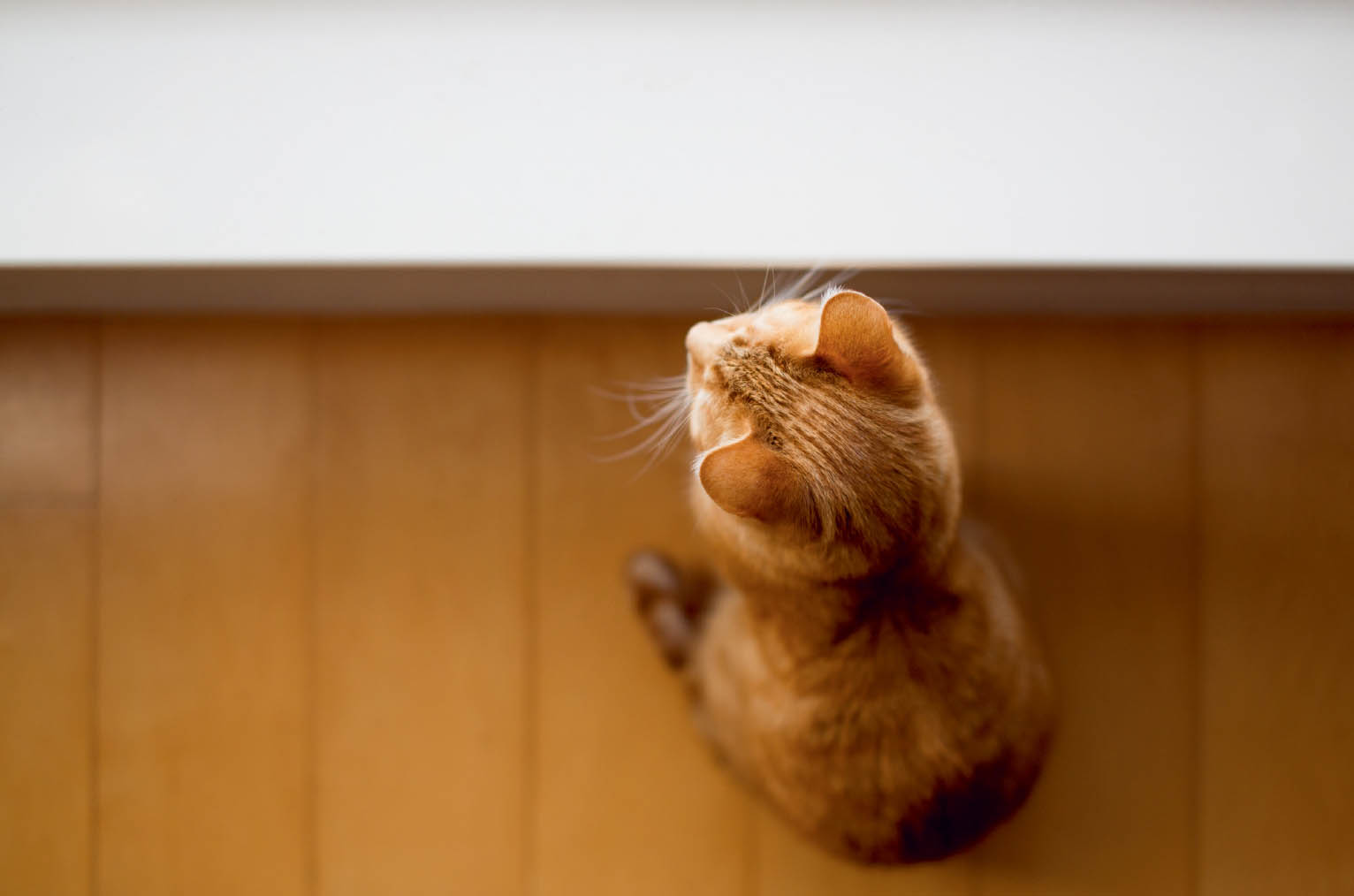
In this image, the cat’s eye and focal point fall into the top third of the frame, according to the rule of thirds.
CROPPING INTENTIONALLY
Choosing exactly what you want and don’t want to include in your pet portraits is a big one for me. When you’re cropping in-camera, make your decisions very intentional. I often remind my students to “crop on purpose.” Here’s what I mean:
Begin to develop the practice of scanning the perimeter of your frame to see if everything that’s included in the frame is supposed to be there (according to you, of course). When you’re photographing a dog, do you want to include their ears and tail in the frame or not? It’s up to you to communicate visually with the viewer of your image by deciding which elements make the cut. If you only crop off the very tip of the dog’s ears, for example, it can look like you weren’t sure if you wanted to include them or not, or that you didn’t even notice them. Handling these kinds of details in this way can become visually awkward and feel unresolved.
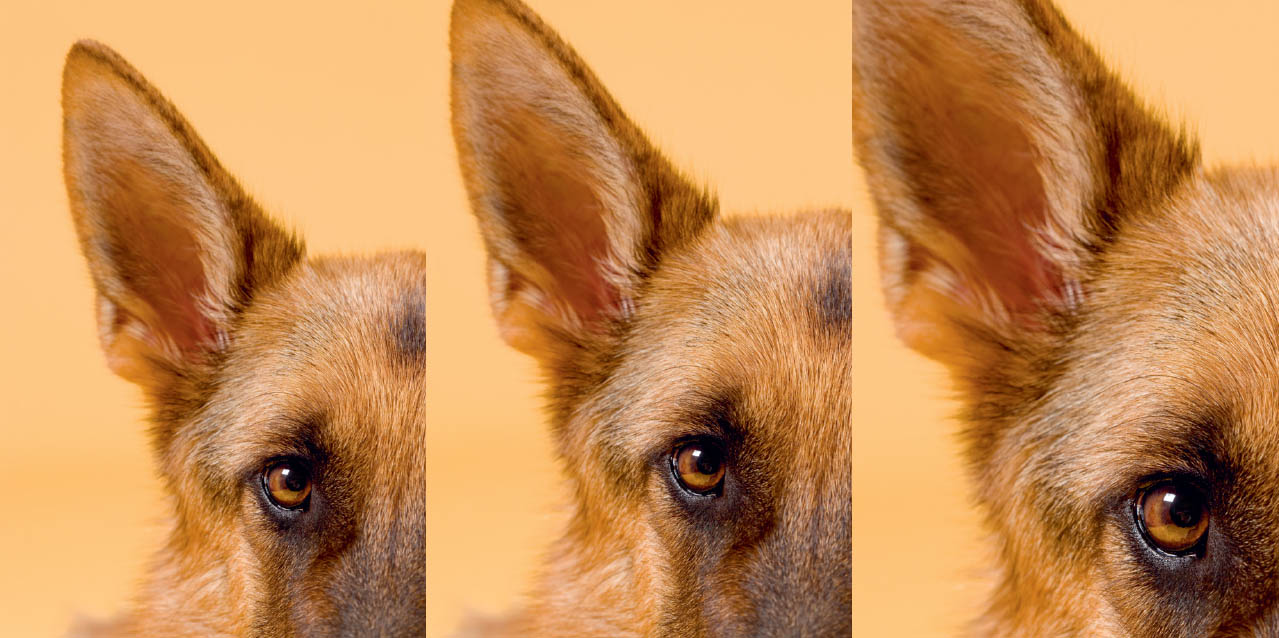
The image on the left includes the dog’s entire ear, and it is obvious to the viewer that I intended to do so. It is not clear in the next image whether I wanted to include the ear or not; thus, it looks visually unresolved. In the third image, there is no mistaking my effort to crop out much of the ear. The difference may seem subtle, but these details make a big difference in your images.
When it comes to cropping legs and arms of animals in-camera, I recommend not cropping right at the joints, as it can become visually uncomfortable. I sometimes love cropping out heads, and when I do, I make sure I go all the way and crop out a head completely, rather than leave a small part showing.
If I crop out a tail of a horse, dog, or cat (or any animal), I am sure to crop out a significant portion of the tail to make it look as if I did it on purpose. Just cropping out the tip of a tail makes it appear as if I didn’t pay attention to the edge of my frame or couldn’t decide whether to leave the tail in or out of the photograph. My philosophy is to either crop out a lot of the ears, tail, legs, and head, or include it all with some breathing room.
Whatever you decide to do with regard to cropping, going far enough in either direction will help indicate to the viewer that you did it intentionally. Of course, you can always make these cropping decisions later, but if you crop out a piece of the pet, you won’t be able to get it back in postproduction. Also, if you always shoot wide and crop in postproduction, you are sacrificing file size.
The more you practice making cropping selections in-camera, the more you are training your eye and the more quickly you’ll be able to make these decisions in-camera.
WATCH YOUR BACKGROUNDS
When we are in the moment of photographing pets, we have a lot to think about. We need to pay attention to posing, exposure, lighting, environment, behavior, communication, composition—and so much more. It can be easy (and I know, because I’ve done it all) not to realize that your camera bag is in the background of your horse portrait, a line in a chair is cutting through a cat’s head, a shape or block of light is creating a major distraction in the background, or your horizon line is super crooked.
Similar to the way that giving attention to the perimeter of your frame is valuable, so is building more awareness of what’s happening in the background of your images and how it connects (or disconnects) visually and contextually with the pet in your image. These factors all add up and can contribute greatly to your final image.
I love to keep my backgrounds simple and ensure that what I am choosing to include—or not include—is intentional!
In order to be able to detect unwanted elements or distractions in your pet images, it can help to take a moment to pause after a few frames to look at your LCD with the specific intention of looking at your backgrounds. Make sure that everything in the image is “supposed” to be there, and then continue photographing once you’ve made any necessary adjustments.
FRAMING
You can greatly add to the interest of your pet portraits through the use of creative framing devices. They help guide the viewer of your image to the important elements—the pets! Anything can act as a framing device, but here are a few ideas to get you started.
NATURAL
Natural framing devices are a great way to lead the viewer’s eye to the pets in your images. Tree branches, grass, rocks, and even light can serve as excellent natural framing elements in pet portraits. If you’re photographing a horse, you might be able to nicely frame the horse’s shape with a group of trees or the edge of a dry riverbed. A dog can be framed by a bunch of tall grasses. A cat can be framed by a colorful bed of flowers. There are many options for naturally occurring framing devices, and they will be highly dependent on the specific location in which you’re photographing. Be on the lookout for framing devices as you are figuring out where to start photographing.
In this image, I used the subtle, natural framing device of the grass to frame beautiful Addy, the sheepdog.
ARCHITECTURAL
Implementing doorways, gates, archways, windows, shelves, walls, and curtains and furniture can be a fun way to visually frame pets. Photograph a dog in a colorful or textured doorway so that the shape of the doorway frames the dog’s body. Position a cat against a brightly colored couch cushion to use the color and shape of the cushion as a framing device. Create an image of a gorgeous horse surrounded by the framing lines of an entranceway to a barn or stall. It can be really fun to look for places as you photograph and think to yourself, “I could put an animal in there!”
Flowing curtains created a beautiful framing device for the kitten in this image. The shape of the curtain leads the viewer’s eye right to the subject.
LEADING LINES
Leading lines provide a guide for the viewer’s eye to follow and can help increase the overall interest of a pet portrait. They do not always need to be straight lines and can even be a line of color, like a row of green trees.
As a few examples, consider placing a dog in a pathway so that the viewer’s eye travels along the lines of the pathway leading right to the dog, or photographing a cat in a windowsill by positioning yourself so the window and curtains create lights that lead right to the subject. A stream of water leading up to a horse and rider can illustrate the concept of leading lines really nicely.
The lines in the bridge help lead the viewer’s eye right to the pup and his person.
While including leading lines isn’t something you’ll be able or necessarily want to do for every photograph, it is another compositional tool to help you build strong pet portrait compositions.
NEGATIVE SPACE
Personally, I love clean and simple images, and these usually involve some amount of white or negative space in my photographs. By placing an animal in the frame and leaving white space, we are providing the viewer’s eye visual “breathing room.” While including lots of information and details within our photographs can sometimes be effective and interesting, it is not always necessary. Less can really be more.
As a general guideline, if a pet is looking to the right or the left, I like to leave the white space in the direction the pet is looking. This helps the image appear compositionally resolved and gives the pet somewhere to look rather than having them look into the edge of the frame.
Because the dog is looking camera right, I left the negative space in the direction of the dog’s glance.
PERSPECTIVE
This is a huge one! You have such creative power with regard to your vantage point as a photographer. Pet portraits can be created from any perspective, and the impact dramatically changes depending on even small shifts in physical point of view. Emotional impact can change greatly with perspective, your backgrounds can be dramatically affected, and even the pets themselves can look different depending on your camera’s point of view.
The best way to figure out your perspective options is to try them on for size. Physically put yourself into different positions, and move your body around to change how your camera sees. As you make these physical changes, you will start to notice how different your photographs look from one another.
Here’s an example of exploring perspective with a dog as your subject.
PHOTOGRAPHING A DOG FROM YOUR EYE LEVEL is a perspective from which you and I are all used to seeing dogs. This is more of an “everyday” view. There is nothing wrong with photographing a dog from this perspective, but because it is more expected, it may not be the most dynamic approach. If you do choose to photograph from this level, consider also trying some other options just to see what happens.
IMAGES CREATED FROM THE DOG’S EYE LEVEL can create the feeling that the camera is another dog interacting with that dog, or perhaps even a child at the same height of that dog. When a dog looks right into the camera at eye level, it supports the connection between the dog and viewer and almost begins to feel as if the dog is looking into your eyes. This requires a bit more physical activity on your part as a photographer; you may have to lie down on the floor or position yourself at various heights to get the camera and dog at the same level.
PHOTOGRAPHING A DOG FROM BELOW, WHILE LOOKING UP, can evoke a little humor and curiosity, or create a feeling of play if distortion occurs as a result of a wide-angle lens. Animals, just like people, look very different when photographed from below. This perspective is not necessarily the “go-to” for every pet portrait, but it can serve as a fun tool in your compositional bag of tricks.
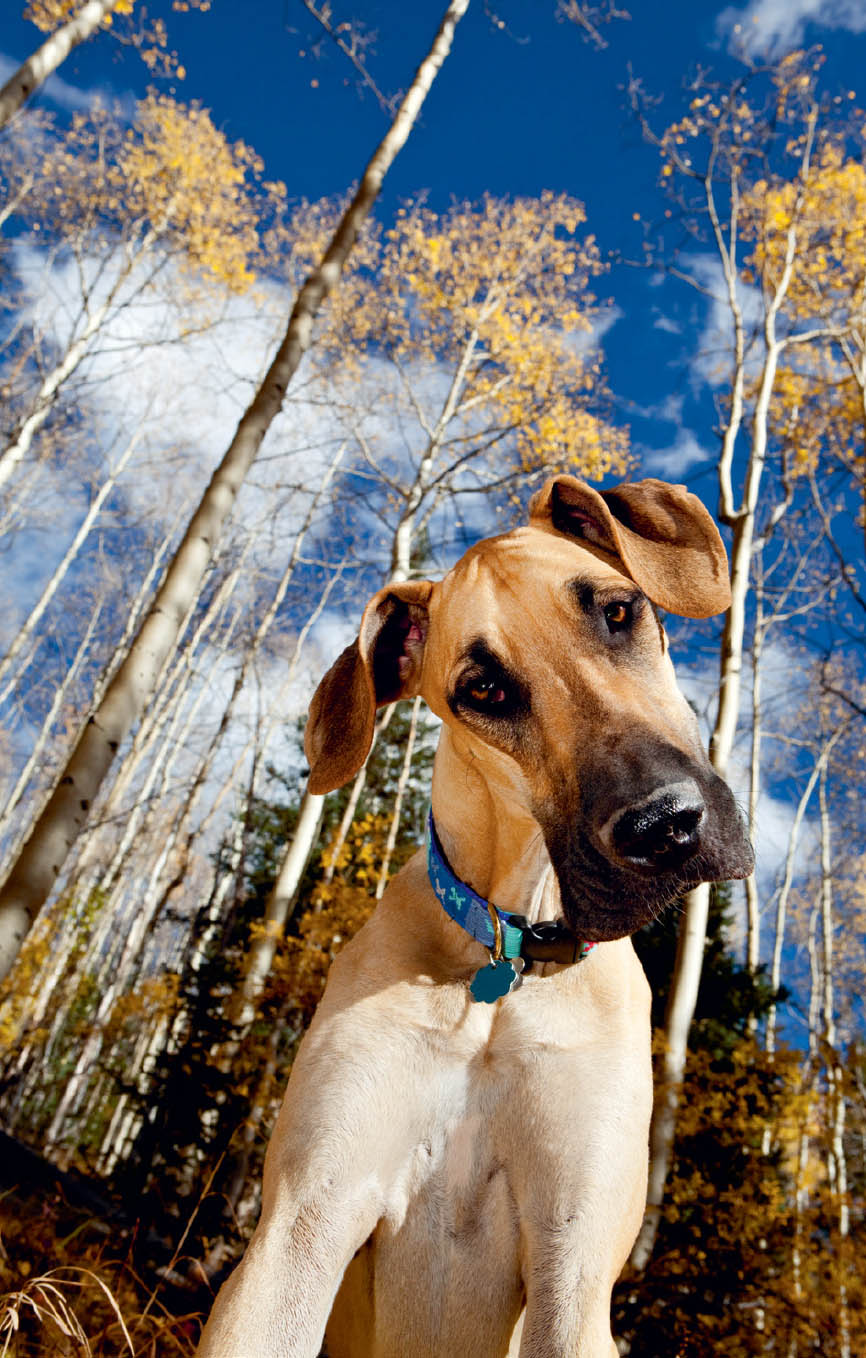
I got down to the ground for this image, so I could photograph Kiya looking down at the camera and include the trees in the background.
I took this image from a high vantage point, above the dog looking down, and she appears to be smiling.
WHEN YOU POSITION YOURSELF LOOKING DOWN ON A DOG, the feeling of that image is quite different from other perspectives. Some people say that it can make the animal look intimidated, but I think this depends entirely on the pet’s demeanor. If the dog has a shy personality, photographing from above might accentuate this trait, whereas a happy-go-lucky Labrador may look up and appear to be smiling. Again, if you find yourself bothered by a feature in the background when using your eye-level perspective or from the dog’s eye level, you can get on a ladder or stool and change the composition of your frame entirely.
There are plenty of viable options when it comes to perspective, and it’s often easier to move your body and camera around than it is to reposition an animal. So keep moving! If you find yourself struggling with less than dynamic compositions, perspective can be a quick way to make a big shift.
DEPTH OF FIELD IMPACTS COMPOSITION
Depth of field can shift the viewer’s eye to different areas of the frame, just like other elements of composition do. Your compositions can drastically change depending on your depth of field choices. A horse, dog, or cat in sharp focus in the foreground can create a very different image compositionally than an out-of-focus animal in the foreground.
You can use a shallow depth of field to bring attention and focus to a dog’s nose, a cat’s whiskers, or a horse’s eye as you allow the background to blur. If you don’t love a particular background, you can use a shallow depth of field to remove unwanted details that will become simpler shapes. In this case, you are simplifying the background and changing the composition, ultimately bringing attention to the pet in your image.
On the opposite side, greater depth of field provides more information and details throughout the image and will impact the composition as a result. With more elements in focus, you need to be very intentional about how you highlight the pet in the composition. For example, a cat in focus with a background that contains a lot of detail will need to be positioned in the frame so that compositionally, the viewer’s eye is still drawn to the animal. The challenge with greater depth of field is that a scene with a lot of details in focus can become overwhelming to the eye, and the pet can get “lost” within the image.
There is not generally a right or wrong way to use depth of field as you develop your compositions. Just keep in mind that your aperture selection is another tool to help guide the viewer’s eye within your images.
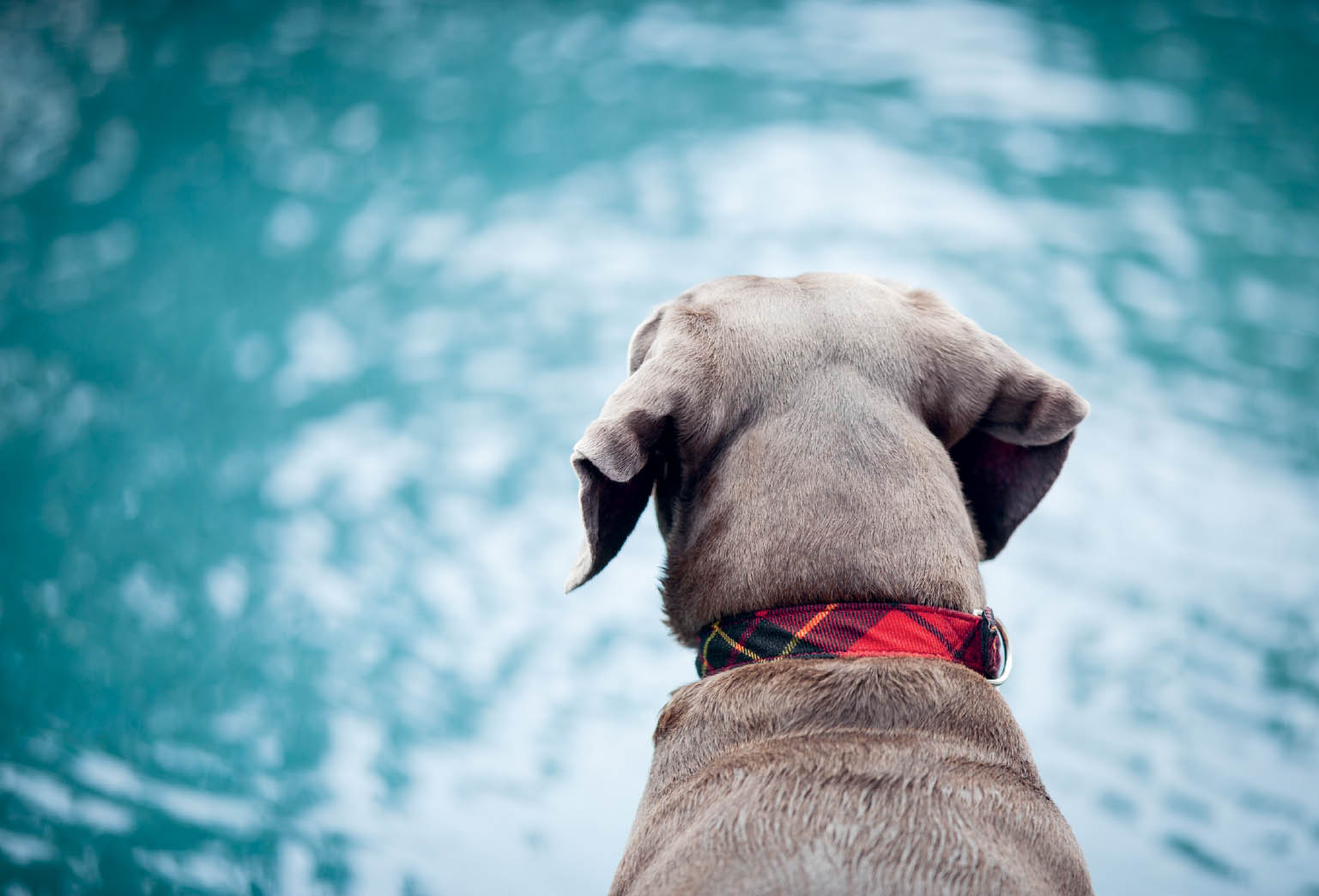
The shallow depth of field drastically impacts the composition in this image.
I love color! I appreciate so much about color in photography—the complexity, both subtle and bold use of color, contrast of colors, and the emotional impact of color in imagery. Color can be used in so many ways to create dynamic images in pet photography.
I have learned to pre-visualize in color (versus black and white), and seeing in this way took some training of my photographic eye. I have practiced noticing color, how I respond to it, and how to use color in my pet photography. I look for color whenever I am photographing, similar to how I look for light.
COLOR CONTRAST
When you look at the choices in backgrounds in relation to the pet you’re photographing, it’s valuable to notice the color contrast of the scene. Color contrast can be intense or really low and quite subtle. Neither is necessarily better, but noticing these values will give you more creative control and technical insight and will help you become more intentional when you’re composing your pet portraits.
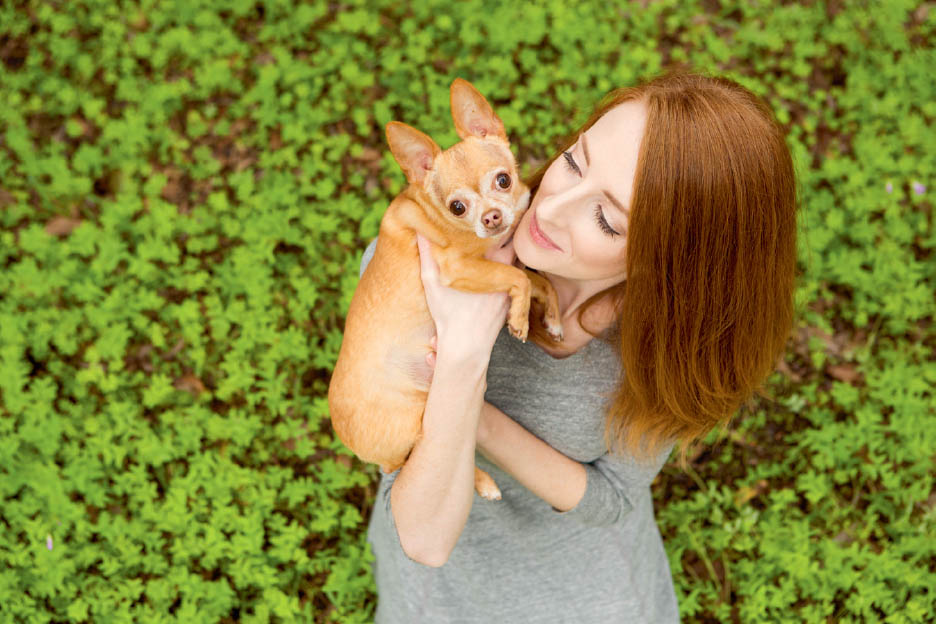
The red in the dog’s fur and the pet parent’s hair complement the green in the background.
USING COMPLEMENTARY COLORS near or next to one another in the frame can be pleasing to the eye and make for dynamic pet photographs. Images with very low color contrast, even monochromatic images, can also be quite beautiful.
COLOR SHOULD PLAY A SUPPORTIVE ROLE in your pet photographs, rather than act as a distraction. Try to use color in your pet portraits to enhance the feeling of the scene or to help bring attention to the animal.
Too much of one color can feel unbalanced in the image and take the focus away from the pet. A dog on a hot pink blanket, for example, can become visually overpowered by the colors if there is a lot of material showing.

My attempt in this image was to highlight the small size of the puppy in comparison to the large couch. Because there is so much red, it becomes too overwhelming and distracting. If this couch were subtler in color, I do not think this would have been an issue.
BRIGHT COLORS CAN BE BROKEN UP if you place the pet in the frame in a way that allows the eye to breathe and the color to surround the pet. Bold colors like red and blue can be very effective even in small amounts and don’t necessarily have to take up a large portion of the frame to be impactful. Subtle, less intense color can be used to create beautiful, elegant portraits.
Color has a tremendous impact on our emotional response, and you’ll want to utilize this in your pet portrait compositions. Not all color elements have to be bright and bold. Remember, the objective of composition is to support the message or feeling you want to convey in the image and to help direct the viewer’s eye toward the pet. We want our compositions to feel complete so that no one particular tool or technique stands out more than another. If the colors in the image are the first thing the viewer notices, you may find that you’re doing a disservice to the pet in the image, because the pet appears to be a visual afterthought.
CONNECTING OR LINKING COLORS is another way to use color to create dynamic pet portraits. This concept was something that became a fun, creative game when I started practicing. Repetition is pleasing to the eye; by repeating colors throughout the frame—for example, foreground to background or subject to background—you can keep the viewer’s eye engaged.
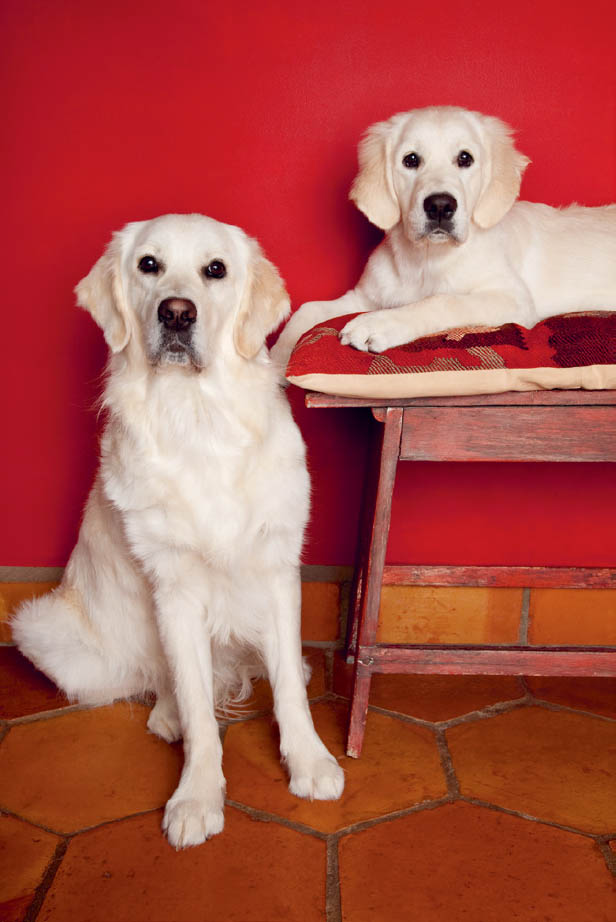
I used the red wall as a background in this image, and because the dogs’ bodies visually interrupt it, the color is not as distracting as with the previous image of the puppy on the red couch.
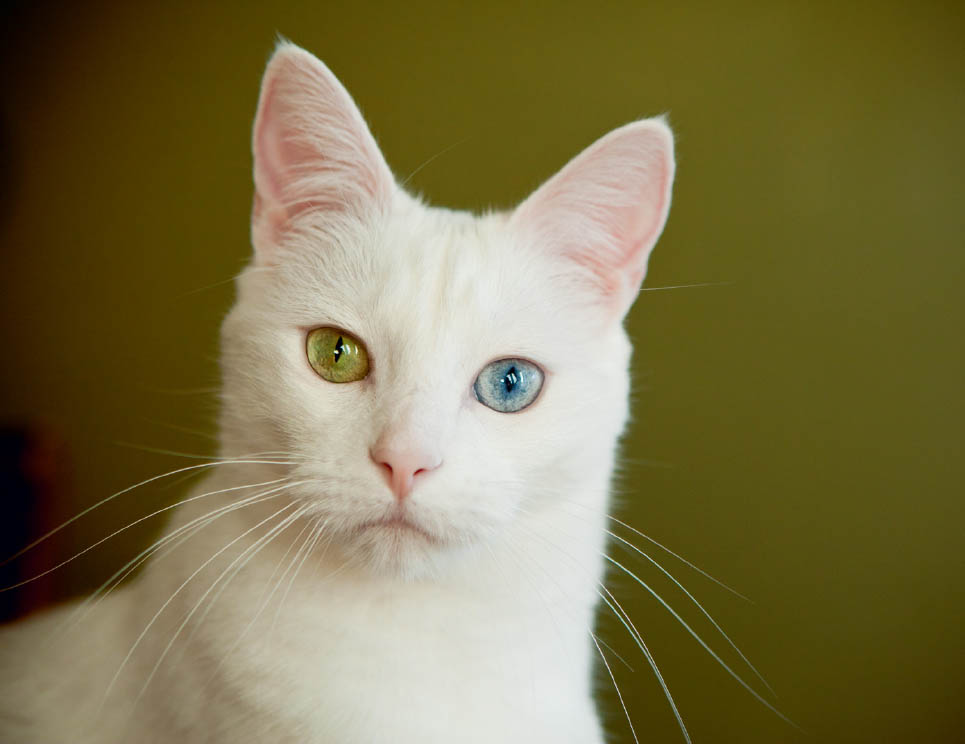
This beautiful cat’s green eye links perfectly with the green background.
A dog with blue eyes can look great against a blue-sky background in the same way that a green collar can really pop against some nice green grass. Challenge yourself to pay attention to the colors available in the frame, and see if you’re able to create color connections within your pet portraits.
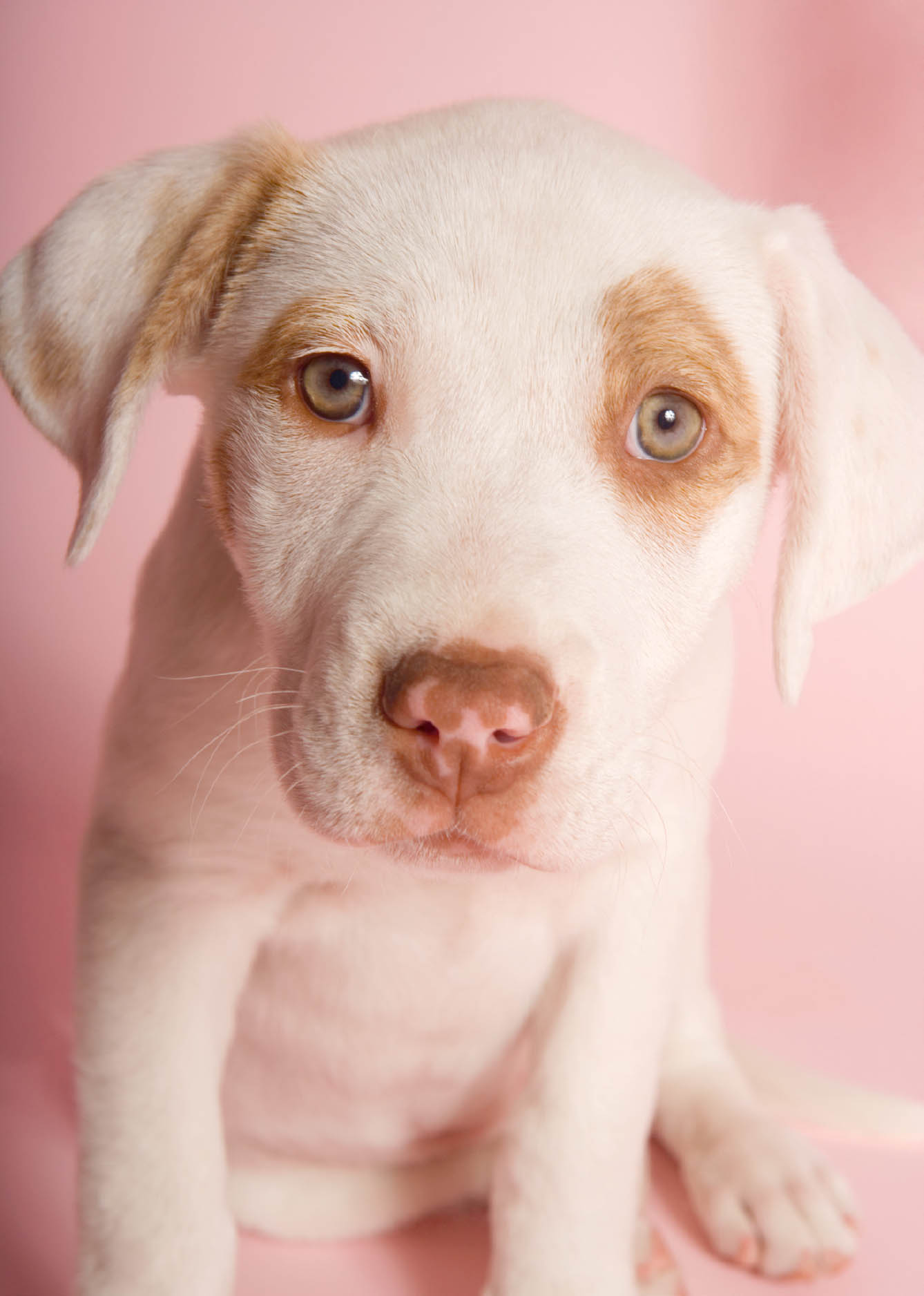
For this studio image, I chose a pink background to tie in with the pink tone of Mika’s nose.
As I mentioned, I love creating pet portraits that go beyond the “headshot” and start to elicit something more personal to the pet parent and viewer, while also exemplifying my work as an artist. Discovering the ways to get creative with your pet images will require some exploration. Consider the following as you continue with your practice.
TELLING A STORY
Visually telling a story with your images is part of what makes photography such a powerful medium. The element of story can be incorporated into pet photography just as it can with any other genre of photography.

This dog loves to make tunnels as she runs through the greenery in her backyard. Photographing her in this space added an element of story to the image.
As a pet photographer, you may choose to visually tell the story of a pet’s personality, their interests, their relationship with their pet parent or another pet in the family, a specific event or adventure, a special talent, or even their journey at the end of their life. Perhaps you are photographing your own pet; if so, think about the story you’d like to tell about him or her. How can you tell that story visually, with your camera?
Story can be conveyed in your pet portraits in many ways. Details like pet toys and beds can be sweet additions to create a reference for a viewer. Interior home environments or backyards can also serve as a reference point to a time and a physical space.
Even when the environment is not very descriptive, the story you’re sharing with the viewer can be as simple and beautiful as a moment of connection between pet and owner. The story of your images doesn’t always need to be dramatic or deep. It can be all about honoring the grace of a horse, the beauty of a dog’s profile, or the sweet mischief of a kitten. The primary consideration when telling a story with your pet portraits is to be clear about the story you are trying to tell. This clarity will help you create more dynamic, authentic pet portraits.
PHOTOGRAPHING IN LAYERS
Photographing in layers can be a fun way to capture portraits of pets and their world. What you choose to include in the foreground and background layers can really turn into a creative endeavor. For example, if you are photographing more than one dog, you can position one of the dogs in the foreground and then either wait or position the second dog in the background to allow the viewer’s eye to travel deeper into the frame.
If you’re photographing pets and people, you can photograph a layer of pets in the foreground and then a reference to people in the background layer for context. Consider the concept of building your photographs and using layers to add dimension.
VISUAL CONNECTORS help you photograph in layers and can be a fun way to tell a story or add depth to your images. There are multiple ways visual connectors can be used to “connect the dots” within your images. Connectors can be aesthetic in nature, as in the color linking mentioned previously, or in referencing a particular environment or sense of place. As an example, if you photograph a horse in the foreground of a barn, the viewer will connect the two elements visually.
INSPIRATION
As I begin to photograph during a pet session, I may not initially feel inspired by the location, the light, or the colors in a scene. But I often notice that once I start, ideas and inspiration start to arise. Be open to the possibility that inspiration for your pet photography can develop as you shoot.
The cascading light in this image offered inspiration to me during the photo session.
Pay attention as you are photographing to what’s working for you creatively and what could use a change. You can even pull together small elements that you feel are strong in your image and use them as a platform to build on. For example, maybe you notice a beam of light on one side of the dog against the wall, and as you continue to photograph, you create a series of images in which the light falls directly on the dog in a dramatic way. This is an example of something you may not have been able to plan before the session but that provided you with inspiration in the moment.
Looking at other photographers’ images can be really helpful in generating ideas as you start to draw elements from multiple artists (pet photographers or any other kinds of photographers and artists, for that matter) to inspire you to create your own unique work.
Discovering Your Style
I like to use the phrase, “discovering your style,” with regard to pet photography, as opposed to “creating your style,” because I don’t think your authentic style as an artist can be forced or even generated on a conscious level. There are many pet photographers in the world—certainly many more than there were when I started in the genre many years ago. While some photographers may have a similar style to yours, no single pet photographer is exactly the same. You are the only one who can do what you do.
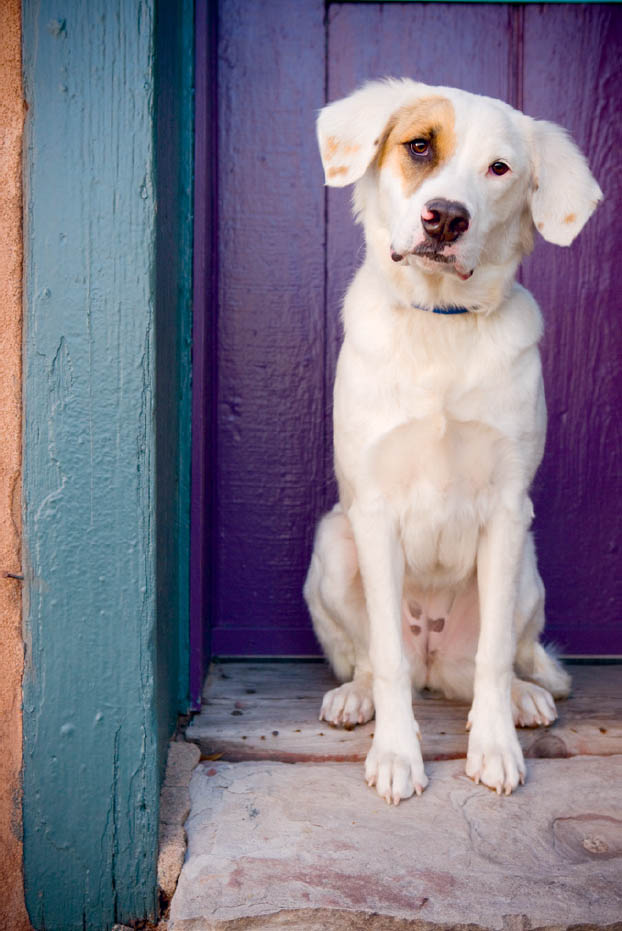
If you are just beginning in pet photography, try not to rush into defining your style too early. Give yourself plenty of room to explore and experiment without limiting yourself to a certain approach or aesthetic. As you continue photographing pets and gaining experience, it may benefit you to start to get a sense of your creative style. To do this, I suggest that you pay close attention to your tendencies and develop a sense of your work overall. Create lots of portraits of pets—your pets, your friends’ pets, your family’s pets, shelter animals—all of them. After you have built up a collection of images, cull your favorites, perhaps creating a Lightroom collection or a folder on your computer.
Once you’ve culled your images, you can examine what you seem to be drawn to as a pet photographer. You might notice an element that tends to recur in your photographs on a fairly consistent level, for example, bold color versus soft color, high contrast versus soft light, details versus abstraction, profiles versus full body, or stopping action versus highlighting movement. You may notice after you’ve had the chance to photograph pets in different scenarios that your preferred approach is one of a documentarian rather than playing an active role in posed portraits.
If you have access to a professional photographer whose work you respect, have that photographer review your images and provide constructive feedback, pulling the strongest images out of the group to make a smaller collection of really great shots. If possible, have that photographer share with you what they believe to be your strengths. Having someone else critique your images can be a very helpful process, because it is easy to become emotionally attached to your work and lose impartiality when judging them. This attachment can hold you back from being objective about the strength of your work, and ultimately, from improving. The “stepping back” exercise can provide tremendous insight on the types of images you tend to create and what type of aesthetic you are drawn to. This is how you start to recognize your style and to develop it.
Build on what you love and on what lights a spark in you as you create pet portraits. Your style can and will evolve over time, just as you do. I’ve noticed that my tendency to create simple, clean images has remained fairly consistent throughout my years as a pet photographer, but my style and techniques have evolved.
If you’ve already been working as a pet photographer and are looking for a “reset,” consider putting together a portfolio; creating or updating a website is an excellent way to reconnect creatively. This process is also a great opportunity to consider what you feel might be missing from your work or a new approach you’d like to explore.
POINT OF VIEW
Your creative perspective or point of view as you’re making pet portraits can vary drastically, has no limitations, and is a direct representation of your style as a pet photographer. Your perspective is unique to you.
My point of view has evolved slightly over time, but for the most part I tend to create contemporary, yet timeless, colorful and simple images of pets and their people. I consider myself a portrait photographer versus a documentary photographer, and in the last few years I have been more drawn to capturing the connection between people and their pets than I have in the past. Occasionally, I will create images with humorous qualities, take on a more documentary approach, or even create a dramatic feel to my work, but for the most part my point of view is to create images that evoke joy.
HUMOROUS IMAGES of pets can be really fun to create. Perhaps these images involve silly props, or wide-angle lenses to exaggerate or distort physical features. Or maybe you use Photoshop to combine illustrations with your photographs. You might choose to create studio sets with pets and add humor or capture a pet in unusual settings or situations.
DRAMATIC IMAGES can be more serious in nature. If you like to photograph in this way, you might enjoy more dramatic lighting, maybe even studio lighting. Black-and-white photographs of pets can often convey a sense of drama and emotion. The drama, whether created with light, location, or in postproduction, will directly impact the emotional response of the viewer.
FINE ART IMAGES of pets might involve a specific style of lighting or a unique treatment in Photoshop or other postproduction technique (via printing or processing) that results in a final product.
CONTEMPORARY OR MODERN PET PORTRAITURE will evolve over time, but this style currently involves creating portraits that have a lifestyle element to them. They are often created in modern-designed spaces, and usually feel fresh and clean in style.
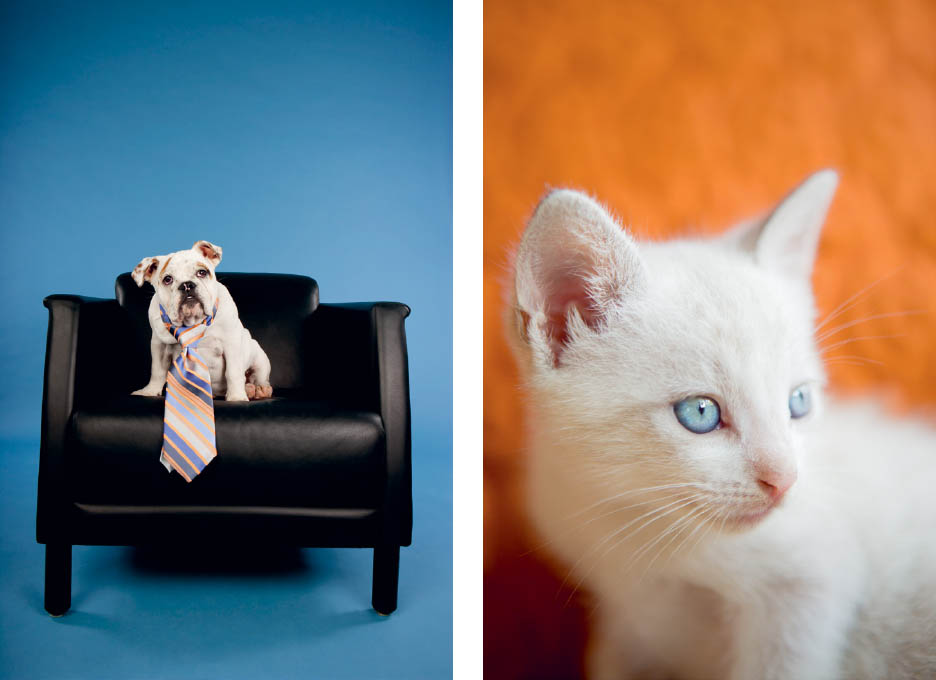
DOCUMENTARY-STYLE IMAGES, wherein you act as a “fly on the wall” creatively recording action and activity, can be quite beautiful. Moments captured without your presence being known to the pets can produce very interesting results. With a documentary approach, you can also shoot from the hip, literally. Many people prefer this way of working, and you may love the experience of photographing pets in this way. While the majority of this book does not focus on the documentary style, it is a completely valid way to create pet portraits.
HAVING FUN
Pet photography can be hard work, but it is integral to your creativity that you are having fun on some level when you are creating. Sure, it can become overwhelming to consider all that is involved with regard to composition, color, and many other factors in a way that brings all the elements together in a final product. At the same time, this challenge can be very rewarding.
The more awareness-based practice you have, the more quickly you’ll be able to make compositional decisions, and in time, you will develop your own creative style. Try your best to learn from what you’ve created, build on it, and enjoy the process.
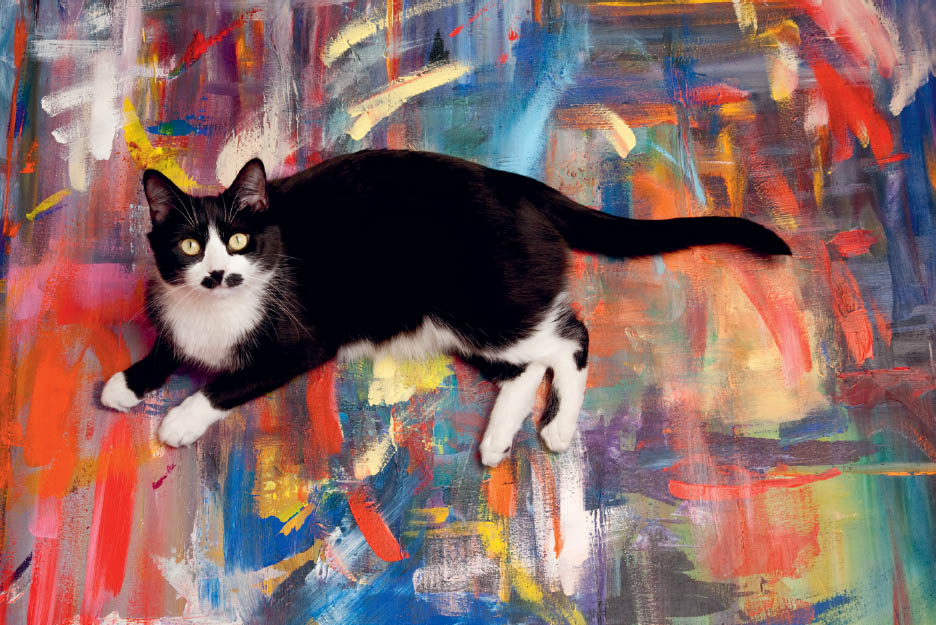
One of my acrylic paintings made for a fun, colorful background for this beautiful tuxedo cat.
Working on location requires responding to many different kinds of lighting. In this image, Kiya is being lit from the sunshine above, and I noticed that I could create a dramatic feel with a little lens flare from light coming directly into my camera.
